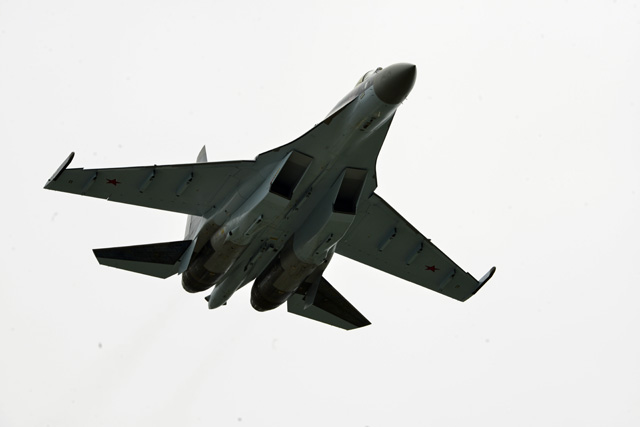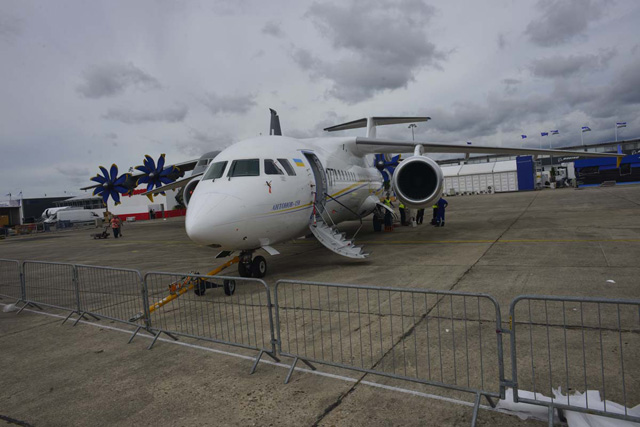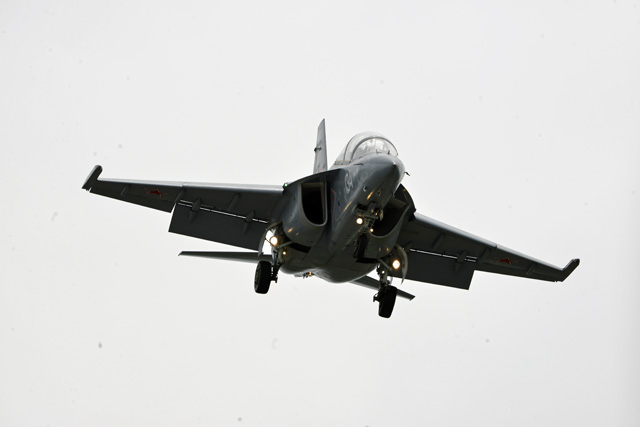Since the break-up of the Soviet Union in 1991, experts have been writing obituaries for the Russian aerospace industry. When the Cold War ended, plummeting defence budgets and the loss of a captive market for its civil airliners in the Communist world meant a once-mighty sector was left starved of funds and with ageing, legacy programmes unable to compete with more modern Western rivals. An industry that boasted some of the brightest engineering brains and with a history of breakthrough technologies was left in seeming terminal decline. "In the 1990s, a lot of people went to the funeral of Russian aerospace," recalls Oleg Demchenko, president of Irkut and a veteran of the Soviet-era industry.
Today those death notices are being ripped up and, although change has been gradual, rather than dramatic, there is a new-found confidence about Russian aerospace. This can be seen in the number of exhibitors and programmes on show at Le Bourget in what the organisers are calling "the return of the Russians". Two all-new civil airliners - the Sukhoi Superjet and the Irkut MS-21 narrowbody, designed and built in Russia, but with substantial involvement from Western partners - have been launched in recent years, and renewed defence spending by Moscow has given a boost to key military programmes such as the Irkut Yak-130, the Sukhoi PAK-FA stealth fighter, fourth-generation Su-35 and Su-34 long-range bomber, and the latest versions of the Mikoyan MiG-29.
 |
|---|
Billypix Sukhoi's Su-35 is making its Paris show debut |
The Su-35 and Yak-130 - as well as the in-service Superjet and a host of military and commercial rotorcraft- are among the types making an appearance at Paris. The creation in the mid-2000s of three state-controlled but independently managed holding groups designed to consolidate all aerospace assets under one central management - United Aircraft, for all the military and civil fixed-wing aircraft, Russian Helicopters and United Engine - has helped streamline its fragmented and dispirited industry and give it strategic focus. The mergers have given the various units scale to commit to ambitious projects such as the Superjet and MS-21, improved the link between design bureaux and production plants and allowed for more coherent marketing messages.
After the collapse of Communist control 22 years ago, the industry's prospects were not helped by a top-down structure designed to fit the needs of a command economy and allow the government to keep a tight rein on the defence and security infrastructure. Design bureaux, based almost exclusively in Moscow, pitched products to the central planners, who in turn awarded contracts. Aided by a network of research centres and specialist universities, these bureaux - named after the fathers of Soviet aerospace such as Sukhoi, Ilyushin, Tupolev and Beriev - branded the programmes, which were produced to order by factories in the far-flung regions. But without direction from Moscow and little in the way of budget, these organisations were largely cast adrift into the free market and forced to scrabble around for what work they could get.
Russia's economic and political turmoil in the 1990s created a stasis in the industry. With a few exceptions, the country's civil aircraft output dwindled to a handful of units a year. Even military programmes were struggling, although export sales did keep that part of the industry off life support. Similarly, overseas demand for its top-selling, highly-specialist medium and ultra-heavy Mil and Kamov helicopters provided a lifeline for that sector. However, even as rising prosperity led to air travel slowly returning to 1980s levels, Russian carriers, including Aeroflot, chose to replace creaking fleets not with home-grown types but with Western airliners. The irony of flying on an Airbus belonging to a state-owned Russian airline cannot have been lost on those hoping the industry could be revived.
All that, however, began to change about a decade ago, as a number of factors came into play. The emergence of Vladimir Putin as president meant Russia's aerospace industry was again being treated as a strategic pillar of the economy, as well as being crucial to the country's security. Defence budgets began to be channelled to new product development. At the same time, Putin and his ministers realised that the legacy structure of the industry - competing design bureaux and a fragmented and now independent network of production plants - was unsustainable. Consolidation and co-ordination under a single umbrella organisation was the solution, and United Aircraft - dubbed the EADS of Russia - was set up in 2006. Russian Helicopters and United Engine followed.
President Mikhail Pogosyan rules over the $6 billion-turnover United Aircraft (known by the OAK acronym in Russian) from an unprepossessing, Stalin-era office block in central Moscow, although a new corporate campus outside the city is being planned. Bringing together Russia's diverse aircraft designers and production plants has not been easy - design bureaux have long, independent heritages and are run by engineers fiercely loyal to the brand, whereas factories are tied into the local economies in the regions they are based. "The process of consolidation is long and complex," says Pogosyan. "But by now, we have received all the assets and centralised the management and are producing consolidated accounts."
The decline of Russia's civil aircraft sector in the 1990s meant United Aircraft inherited an industry very much weighted towards defence production. "Two years ago, 90% of our sales were military, but we are moving to a more balanced structure," says Pogosyan, promoted to his current role after running Sukhoi for many years. "This year, transport and civil will be 20%. Between 2020 and 2025, they will get to 50%." Helping towards that goal will be the two new commercial programmes for which United Aircraft is banking on strong export sales: the Superjet and MS-21. It expects to sell 70% of the aircraft outside Russia. Both programmes come under the auspices of United Aircraft, although Italy's Alenia Aermacchi has a 25% share of Sukhoi Civil Aircraft and markets the Superjet in the Western hemisphere.
 |
|---|
Billypix |
Pogosyan also plans an organisational restructure to create an entity modelled more on EADS in Europe. So far, the consolidation has left the legacy businesses largely intact, but with closer integration between design bureaux and factories, a central management structure and one set of accounts. "The main restructuring will be over the next five years," says Pogosyan. That stage involves bundling the assets into divisions that reflect the four main markets: military, commercial, transport and specialised. The latter two include niche products from Antonov, Ilyushin and Beriev, ranging from outsized freighters to water bombers. However, this will not mean an end to the famous names. "These have their value and place and future," says Pogosyan. "We won't be marketing aircraft under a single brand."
He is confident that new military programmes for Russia and its main overseas partner, India, robust defence export sales and upgrades of existing aircraft, and, in particular, the success of the civil programmes should see United Aircraft's turnover top $7 billion this year, hit $10 billion by 2015 and double that figure by the close of the decade. While the new airliners could provide that step change, it is United Aircraft's military portfolio that has kept Russian industry in business over the past two decades and is now also looking to a new generation of aircraft.
These include the PAK-FA, a fifth-generation stealth fighter being developed with India, and intended as a replacement for the Su-27 and MiG-29. It flew in public for the first time at Moscow's MAKS air show in 2011, will enter operational testing in 2014 and service two years later. The aircraft has been launched on the back of commitments from Russia and India but has "good export potential", in countries that operate Sukhoi and MiG fighters. "It will complement future versions of these aircraft," says Pogosyan.
Making its overseas debut at Paris is the Su-35, a development of the Su-27 Flanker and a type Pogosyan describes as the "world's best fourth-generation fighter, despite the fierce competition". He hints at a sales announcement at the show. Another upgraded version of the Su-27, the Su-30MKI, continues in production, largely helped by a deal in 2000 by India to licence manufacture 140 of the aircraft. Export customers for other Sukhoi aircraft include Indonesia, which will take delivery of four more Su-30MK2s by the end of the year, taking its fleet to nine and total Sukhoi inventory to 16. Another evolution of the Su-30MK with enhanced avionics and other equipment, the Su-30SM, has been in flight testing since last year.
With the Yakovlev and RAC MiG brands also in its portfolio (see boxes), Pogosyan is confident that United Aircraft's military business will remain strong. However, he is aware that Russian industry - unlike the Soviet Union during the Cold War - cannot do it all itself. While design and manufacturing alliances, as well as supplier deals, are often necessary on the defence side - as with the PAK-FA - in its civil business, Russian industry has gone out of its way to secure foreign programme involvement. "Partnerships are a strategic imperative," says Pogosyan. "We should integrate all the best technologies from the international market. In return, we are able to offer our partners things that no-one else can."
MIKOYAN
Although RAC MiG's glory days of producing hundreds of fighter aircraft for the Soviet and other air forces may be behind it, the Moscow-based United Aircraft subsidiary is pressing ahead with plans to upgrade and export its existing aircraft models, of which the iconic MiG-29 lightweight combat aircraft is the flagship.
"We are a dynamically developing company," says general director Sergey Korotkov, who, contrary to the belief that RAC MiG is simply a design bureau, insists that its a "full-cycle" business, able to develop, test, manufacture, sell, maintain and upgrade its products.
The MiG-29 was developed in the late 1970s and went into service with the Russians in 1983. Around 800 remain in service in 24 countries around the world, and Korotkov says the company's priority is to "maintain the status" of that and other RAC MiG types still in operation by offering revamped versions to existing and new customers.
The MiG-21 is arguably the longest-produced combat aircraft in history, with the first model going into service in 1959 and manufacturing only stopping in 1985. India is among its operators and Korotkov visited the country in May to celebrate its 50th anniversary of service with its air force. "They will continue to fly it until 2020, which is a vivid example of its performance," he says. "Of course, it has had many upgrade packages. I cannot think of many programmes that have had so many upgrades."
Serbia is another long-time MiG operator, which is looking to replace six of its older MiG-29s with the newer MiG-29M/M2 variant. "We recently demonstrated the latest version of the aircraft there and we have a great chance," suggests Korotkov.
Another major project is an upgrade of around half of the Russian air force's 122 MiG-31 interceptors to MiG-31BM standard. The package includes multimode radar, multifunction cockpit displays and ability to use Vympel's RVV-BD long-range air- to-air missile. Although the air force commander has suggested that the MiG-31s may all be replaced by 2028, Korotkov says the upgrade enhances their effectiveness and life considerably. "The MiG-31 is a unique aircraft that still holds a lot of world records," he says. " I hope it will be with our air force for a long time."
YAKOLEV
The Yak-130 is appearing at Paris this week for the first time since the 1990s, the decade in which Yakovlev developed the advanced trainer and lightweight combat aircraft with its then Italian partner, Aermacchi. Yet Irkut, the United Aircraft subsidiary that now owns the Yakovlev brand, has only just begun delivering the aircraft to its domestic customer.
"For many years we were oriented to the export version of the aircraft until we finally got an order from our MoD in December 2011," says Irkut president Oleg Demchenko. The company has delivered the first 18 examples of 55 aircraft, with all due to go into service by 2015. Other countries flying the Yak-130 include Algeria, but Demchenko hints at two further deals and hopes to sway additional potential customers at Paris.
 |
|---|
Billypix |
The Yak-130 was developed alongside the (now) Alenia Aermacchi M-346 in what Demchenko says was the "first contract between Russia and the West to create an aircraft together". However, the two partners parted ways at the end of the 1990s, with the Italian company deciding to develop an advanced trainer, and its Russian counterpart a more conventional combat aircraft.
Although the two types look almost identical externally and have "a lot of features in common", they follow different design philosophies, says Demchenko. "We remain friends but we chose different paths." The Yak-130's key quality is that is is "simple to fly, even for cadets with very little experience," he says. "You cannot spin it, even if you wanted to. This is a most important feature for young pilots."
Source: Flight Daily News
















